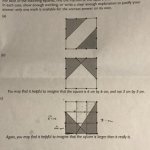JamesWilko
New member
- Joined
- Feb 12, 2018
- Messages
- 1
Can you help with this Math problem? It's from a scholarship paper for 12-13 year olds. I have to work out what fraction of the entire square the shaded region is.
I've worked out that it's 47/90 and have verified that by drawing it on an architect's sketching program. Thing is the method I used I know is much more complicated than it needs to be and I don't know how to explain it simply to my student.
To work out the perpendicular height of the triangle where the two larger triangles overlap I worked out where they intercept using y=mx+c, but my student isn't expected to know that at this age.
Can someone suggest the simple way of doing this that I'm missing? Thanks
I've worked out that it's 47/90 and have verified that by drawing it on an architect's sketching program. Thing is the method I used I know is much more complicated than it needs to be and I don't know how to explain it simply to my student.
To work out the perpendicular height of the triangle where the two larger triangles overlap I worked out where they intercept using y=mx+c, but my student isn't expected to know that at this age.
Can someone suggest the simple way of doing this that I'm missing? Thanks

